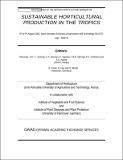| dc.contributor.author | JC Onyango | |
| dc.date.accessioned | 2020-08-14T09:06:48Z | |
| dc.date.available | 2020-08-14T09:06:48Z | |
| dc.date.issued | 2002 | |
| dc.identifier.uri | https://repository.maseno.ac.ke/handle/123456789/2124 | |
| dc.description.abstract | Water hyacinth has long been perceived as a problem for shipping and fishing industries and only more recently as a
threat to bio-diversity. It can undergo rapid proliferation, forming dense mats of plants that cover water bodies, so
reducing light and oxygen and changing the water’s chemistry, fauna and flora. It poses a real risk to human activities
especially horticultural around the Lake region. The undesirable effects of water hyacinth, which has been over
emphasized, are strongly due to its ability to multiply and spread rapidly as a weed covering the fresh water surfaces
causing several problems. However, the plant can be used as bio-fertilizer in horticultural production, for animal feed
and biogas production. Physiological experimentation have shown that water hyacinth has a high nitrogen and
phosphorus loading that can be made available to the growing crop on decomposition. | en_US |
| dc.publisher | Department of Horticulture Jomo Kenyatta University of Agriculture and Technology, JKUAT | en_US |
| dc.subject | Eichhornia crassipes, reproductive biology, uses, Lake Victoria Region | en_US |
| dc.title | Water Hyacinth (Eichhornia crassipes) Management and Utilization in the Lake Victoria Region | en_US |
| dc.type | Article | en_US |

